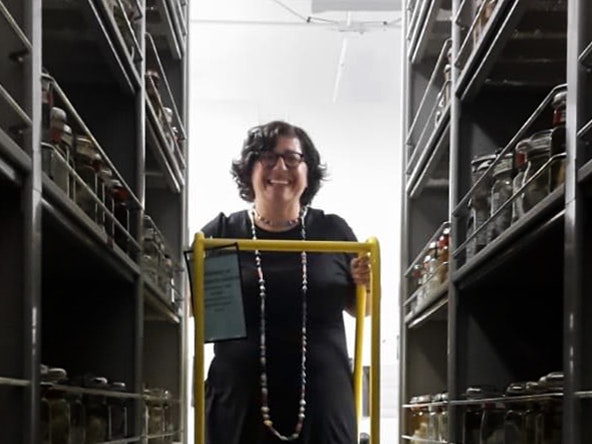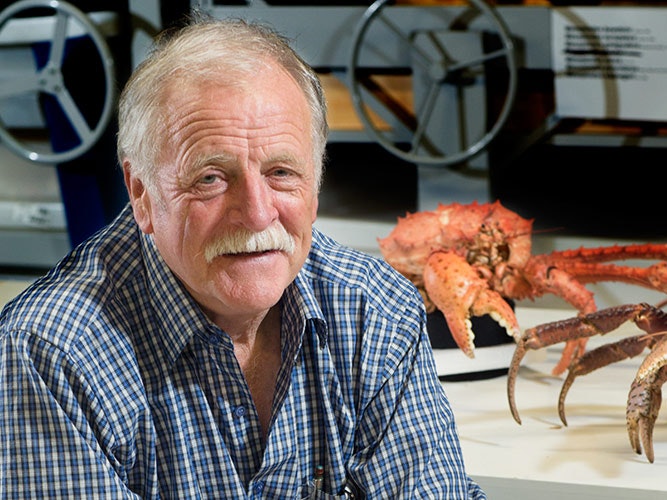
Meet the carcinologists: Rachael Peart
Carcinologists are the people who study the world of crustacea. In this series, they talk about the captivating creatures they love – creatures that as it turns out live all around us…
Free museum entry for New Zealanders and people living in New Zealand
Open every day 10am-6pm
(except Christmas Day)
Free museum entry for New Zealanders and people living in New Zealand
Carcinologists are the people who study the world of crustacea. Three of those experts have helped to shape Clever Crustaceans in partnership with NIWA Taihoro Nukurangi.
Here, NIWA Taihoro Nukurangi expert Dr Kareen Schnabel talks to MScSoc graduate Poppy McGuigan Hay about her work in the world of crustaceans.
Kareen in front of an iceberg in the Ross Sea, 2008 IPY CAML voyage on the RV Tangaroa . Photo by David Bowden. NIWA
Originally from Germany, Kareen always wanted to be a marine biologist, fossicking the seas for new species. Kareen is now an expert on deep-sea crabs, shrimps, and lobster around Aotearoa New Zealand.
KS: A relatively small group of primarily deep-sea crustaceans called squat lobsters are probably the dearest to me. I spent my PhD studies at the University of Otago and NIWA familiarising myself with them, describing over 30 species, and developing a close network of international colleagues.
KS: My first experience working with crustaceans was in 1997 when I came to New Zealand after completing my undergraduate studies in Germany.
At Waikato University, the late Prof. Ann Chapman introduced me to classical taxonomic methods of preparing, identifying and describing new species when I started an MSc looking at the population genetics of freshwater and estuarine amphipods around the North Island.
I then worked at the University of Guelph in Ontario, Canada, where we sampled and DNA sequenced Arctic invertebrates – my focus remained on amphipods, this time marine - and I also worked as Research Associate at the Lee Stocking Island Marine Research Station in the Bahamas, where I supported various research projects, maintained the NOAA coral bleaching monitoring station, and a spiny lobster recruitment and grow-out study.
KS: A scientist whose studies include crustaceans. These might be ecologists, palaeontologists, molecular or larval biologists or any other discipline. Crustaceans are everywhere, which makes them pretty easy to find and study.
KS: They are versatile and everywhere, from the deepest parts of our oceans to slopes of mountains. Their body parts are so adaptable, they have evolved a myriad of shapes and sizes over time which is absolutely fascinating.
KS: For my PhD I arrived in Aotearoa and there were only about two dozen squat lobster species known in the region. Over the next four years, I identified specimens and found nearly 200 species overall, many of them new. And by analysing their DNA, I could for the first time confirm their evolutionary relationships within the group (turns out the two main groups of that time were distantly related and not sister groups as typically assumed) and to other crustaceans. (they are related to hermit crabs, king crabs and porcelain crabs and not true lobsters.
KS: I always cherish the time I get to spend describing new species. At the moment, I am finishing a species description of blind vent and seep shrimp from our deep waters. And I am working on a big account of our ghost shrimp which are diverse but have never been looked at in detail. As a consequence, there are many species that have never been previously reported from our region, but are known elsewhere, and there are at least half a dozen of undescribed species.
KS: My colleagues, I love to work at a place like NIWA where there are people from all disciplines mixed in with each other. A great way to learn new things.
KS: Crustaceans are great study subjects, but don’t forget the broader picture. I found my general science undergrad very helpful when it came to narrowing my focus for my graduate studies and beyond. Don’t specialize too soon.
KS: There is so much more to crustaceans than crabs and crayfish, we now know of more than 3300 species, one of the most diverse animal groups we know of in Aotearoa.

Carcinologists are the people who study the world of crustacea. In this series, they talk about the captivating creatures they love – creatures that as it turns out live all around us…

Carcinologists are the people who study the world of crustacea. In this series, they talk about the captivating creatures they love – creatures that as it turns out live all around us…